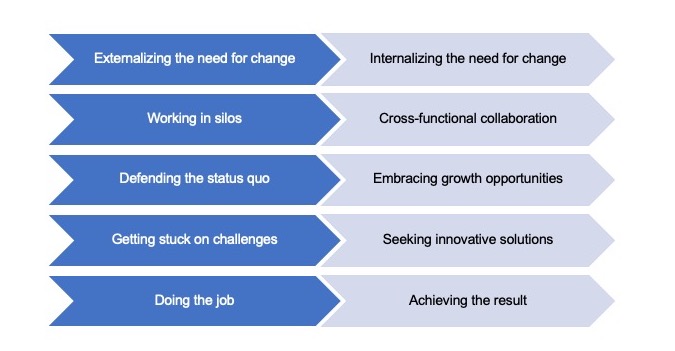Organizations right now have different workplace cultures than they did six months ago. Between work-from-home arrangements and the need to focus on short-term planning over long-term strategy to navigate an unknown future, across industries employees need new ways of connecting, performing, and thinking.
We’ve witnessed organizations with strong cultures shift in response to these challenges more effectively than those with undefined and unmanaged cultures. These companies also have the tools and knowledge to rebuild their cultures for a new future, whatever that future may be.
Culture management is an investment. It’s something that requires intentionality and ongoing commitment. Those companies that do so reap big rewards. Of course, right now we don’t have the luxury of time and foresight. If short-term strategy guides businesses today, we need comparable short-term culture management tools to bring the strategy to life.
While culture management looks differently today than it did last year, and will probably shift to look different yet again in 2021, there are some pillars to culture management that hold up through the test of time. Here are three steps you can take today to manage your culture.
Step 1: Get Clear About Your Results
The culture you have today delivers the results you achieve. If you want different results, you have to shape a different culture. This is the guiding principle of our book Change the Culture, Change the Game.
How do companies perform a culture shift to deliver new, better, or different results than they were achieving six months ago?
Many business leaders just don’t know where to start. Even in a “normal” year, they feel culture is ambiguous, it would take too long to try to change, and it’s something they can’t fully grasp or understand, much less leverage to gain any business advantage.
But this is only because these leaders are not clear on what culture really is or what they want their culture to produce. Culture is much more than socials and company perks. We define culture as, “The way people think and act.”
To get different results, we need to help people think and act in a different way.
This sounds tricky. How do you get people to think and act differently? We could try to tell them, bribe them, or force them to change how they think and act, but experience has shown us how well that works. (It doesn’t.)
Instead, the most effective way to initiate a culture shift is to shift the way people think and act is to first get clear on the results we need to achieve and then get to work in Step 2 with defining the shifts needed in our culture to deliver those results.
Step 2: Define the Culture Shift
What is the culture shift you need today? How do you need people to think and act differently?
Many are working to shift their business to more virtual-centric operations and approaches. But is this enough? In a recent meeting with a senior leader at a Fortune 10 organization, she shared that their organization isn’t just looking for their people to work from home; they don’t just need more virtual-delivery options for their products.
What they really need is for people to embrace agility.
The rate of change isn’t going to slow down. While they do need many on their team to tactically work from home right now, they need a larger shift in how their people think and act around agility.
Common Mindset Shifts Needed Today

Defining the shift and naming it gives us power to transform our culture. Otherwise, it’s easy to rely on the default mindset that “we need to improve our culture.” This obtuse objective often permeates organizations, with little impact or lasting change. Instead, get specific and clear about what type of culture you need to deliver desired results.
Step 3: Act on the Culture Shift
Once you define the shift in your culture, we need to ensure we don’t fall into the trap of writing up the shift, sending it out in an email campaign, putting it on posters, and thinking this will make an impact.
Internal communication is important; but unless that you follow that up and support it with real action throughout the organization, any needed shift will fall flat.
An internal team at a global financial organization had the highest-turnover, lowest engagement scores in the company. The head of this team admitted they had some significant shifts they needed to make. At the top of the list was a belief that their team’s purpose was to only police other teams within the organization. You can imagine some of the challenges this would bring up if this was their belief.
We worked with them to flip this around, and soon a meaningful shift became clear: they were going to shift from policing others to delivering value in every interaction.
They started out by communicating globally that this was their focus. They kept this shift as a focus on their team by giving each other feedback around the shift, sharing recognition when someone demonstrated this shift in action, and telling the stories and experiences they were having on a daily basis.
They didn’t just define their culture shift, they communicated it and then acted on it. Within a year, they went from worst to first in employee engagement numbers and delivered record-breaking results working with internal teams that now clearly saw them delivering value in every interaction.
Culture Management Remains Essential for Businesses
The importance of managing culture cannot be overstated: culture impacts results, and if you need new, better, or different results, you need to ensure you align your culture to deliver on those new results.
Too many of us fall victim to hoping that our Q1 2020 Culture can deliver our Q4 2020 Results.
Louis Gerstner, former CEO of IBM, shared what he learned over his career:
“When I came to IBM, I probably would have told you that culture was just one among several important elements in an organization’s makeup and success — along with vision, strategy, marketing, financials, and the like. I came to see, in my time at IBM, that culture isn’t just one aspect of the game. It is the game.”
With culture as the game, how do you win?
By making the needed real-time shifts to your culture. And it starts by first understanding what culture is and how it works; defining the shifts so everyone is clear on what needs to be done; and finally, acting on those shifts in a purposeful manner to help you deliver results.




